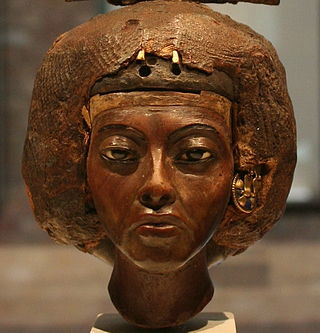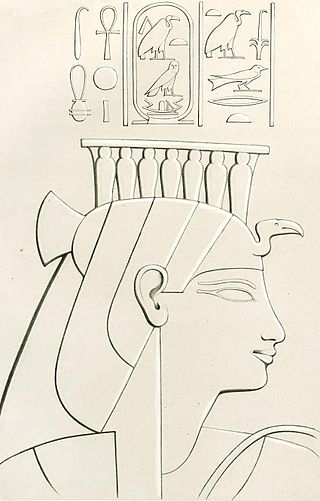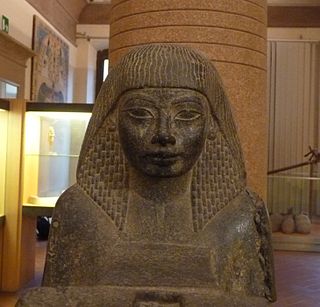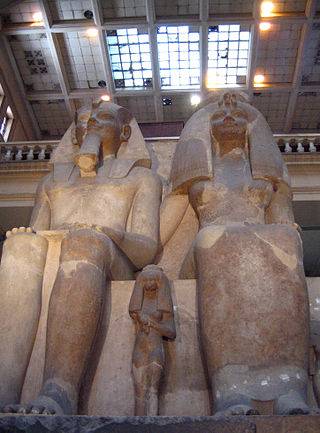
Tiye was the Great Royal Wife of the Egyptian pharaoh Amenhotep III, mother of pharaoh Akhenaten and grandmother of pharaoh Tutankhamun; her parents were Yuya and Thuya. In 2010, DNA analysis confirmed her as the mummy known as "The Elder Lady" found in the tomb of Amenhotep II (KV35) in 1898.

Amenhotep III, also known as Amenhotep the Magnificent or Amenhotep the Great and Hellenized as Amenophis III, was the ninth pharaoh of the Eighteenth Dynasty. According to different authors, he ruled Egypt from June 1386 to 1349 BC, or from June 1388 BC to December 1351 BC/1350 BC, after his father Thutmose IV died. Amenhotep was Thutmose's son by a minor wife, Mutemwiya.

Thutmose IV was the 8th Pharaoh of the 18th Dynasty of Egypt, who ruled in approximately the 14th century BC. His prenomen or royal name, Menkheperure, means "Established in forms is Re." He was the son of Amenhotep II and Tiaa.

The Precinct of Mut is an Ancient Egyptian temple compound located in the present city of Luxor, on the east bank of the Nile in South Karnak. The compound is one of the four key ancient temples that creates the Karnak Temple Complex. It is approximately 325 meters south of the precinct of the god Amun. The precinct itself encompasses approximately 90,000 square meters of the entire area. The Mut Precinct contains at least six temples: the Mut Temple, the Contra Temple, and Temples A, B, C, and D. Surrounding the Mut Temple proper, on three sides, is a sacred lake called the Isheru. To the south of the sacred lake is a vast amount of land currently being excavated by Dr. Betsy Bryan and her team from the Johns Hopkins University in Baltimore, Maryland.

The Mortuary Temple of Amenhotep III, also known as Kom el-Hettân, was built by the main architect Amenhotep, son of Hapu, for Pharaoh Amenhotep III during the 18th Dynasty of the New Kingdom. The mortuary temple is located on the Western bank of the Nile river, across from the eastern bank city of Luxor. During its time, the Mortuary Temple of Amenhotep III was the largest funerary complex in Thebes that was built. Only parts of the mortuary temple's layout remain, as well as the Colossi of Memnon, which are two large stone statues placed at the entrance measuring 18 meters high. Because the mortuary temple was built relatively close to the river, the annual flooding caused the site to decay at a more rapid rate. New research indicates that a large majority of the destruction on the mortuary temple can be attributed to the effects of an earthquake. It was long speculated that the earthquake occurred around 27 BC; however, investigations into the mortuary temple and surrounding colossi have debunked this time frame and instead have demonstrated it occurred around 1200 BC. Additional earthquakes after the one in 1200 BC have not been ruled out. The Colossi of Memnon and Amenhotep III Temple Project have helped conserve the site as well as possible.

Mutemwiya was a minor wife of the Eighteenth Dynasty pharaoh Thutmose IV, and the mother of Pharaoh Amenhotep III. Mutemwiya's name means "Mut in the divine barque". While unconfirmed, it has been suggested that she acted as regent during the minority of her son Amenhotep III.
Alexander Badawy was an Egyptian Egyptologist. He was born in Egypt and taught Egyptology in the United States. He was professor of art history at UCLA, and after he became emeritus, he endowed a chair at Johns Hopkins University, currently held by Betsy Bryan.

Thutmose was the eldest son of Pharaoh Amenhotep III and Queen Tiye, who lived during the Eighteenth Dynasty of Egypt. His early death led to the reign of Akhenaten, his younger brother—as the successor to the Egyptian throne—and the intrigues of the century leading up to Ramesses II, the start and ultimately the failure of Atenism, the Amarna letters, and the changing roles of the kingdom's powers.

Siatum was an ancient Egyptian prince of the 18th Dynasty. He was likely one of the sons of Pharaoh Thutmose IV and thus the brother or half-brother of Amenhotep III.
The ancient Egyptian official named Menna carried a number of titles associated with the agricultural estates of the temple of Karnak and the king. Information about Menna comes primarily from his richly decorated tomb in the necropolis of Sheikh Abd al-Qurna at Thebes. Though his tomb has traditionally been dated to the reign of Thutmose IV, stylistic analysis of the decoration places the majority of construction and decoration of the tomb to the reign of Amenhotep III.

Tiaa or Tia'a was an ancient Egyptian queen consort during the Eighteenth Dynasty of Egypt. She was a "faceless concubine" during the time of Amenhotep II who withheld from her the title Great Royal Wife, but when her son Thutmose IV became pharaoh, he performed a revision of her status and gave her that title.

The Theban Tomb TT57 is located in Sheikh Abd el-Qurna. It forms part of the Theban Necropolis, situated on the west bank of the Nile opposite Luxor. The tomb is the burial place of the ancient Egyptian official Khaemhat, who was royal scribe and overseer of double granary, during the reign Amenhotep III. The relief decoration of the tomb is regarded as the best of New Kingdom art.

The Dream Stele, also called the Sphinx Stele, is an epigraphic stele erected between the front paws of the Great Sphinx of Giza by the ancient Egyptian pharaoh Thutmose IV in the first year of the king's reign, 1401 BC, during the 18th Dynasty. As was common with other New Kingdom rulers, the epigraph makes claim to a divine legitimisation of kingship.

During the reign of the ancient Egyptian pharaoh Amenhotep III hundreds of so-called memorial scarabs were issued to commemorate the deeds of the pharaoh. Such scarabs were found in several archaeological sites of the Near East, from Syria to Sudan. Over two hundred of them are known to exist in museums and collections around the world.

The colossal red granite statue of Amenhotep III is a granite head of the 18th Dynasty ancient Egyptian Pharaoh Amenhotep III. Dating from around 1370 BCE, it was found in the temple enclosure of Mut at Karnak in Upper Egypt. Two parts of the broken colossal statue are known: the head and an arm. Both parts are now in the British Museum.

The Eighteenth Dynasty of Egypt is classified as the first dynasty of the New Kingdom of Egypt, the era in which ancient Egypt achieved the peak of its power. The Eighteenth Dynasty spanned the period from 1550/1549 to 1292 BC. This dynasty is also known as the Thutmosid Dynasty for the four pharaohs named Thutmose.

Ptahmose was Overseer of the seals (Treasurer) under Amenhotep III, during the 18th Dynasty of Egypt.

The Sekhmet statues, dating back to the New Kingdom of Egypt during the 18th dynasty and later dynasties, are statues of the Egyptian goddess Sekhmet.

Meryre was an ancient Egyptian official under king Amenhotep III in the 18th Dynasty around 1375 BC. His main title was treasurer. He was therefore one of the most important officials at the royal court, looking after the belongings of the king and the goods of the palace. Meryre is so far only attested in his tomb at Saqqara, that was discovered in the 1980s in the temple area known as the Bubasteum. The tomb is decorated with reliefs. Some of them were already early on cut out of the walls and sold on the art market. Two of these reliefs are now in Vienna. Old drawings show that they were once in a much better condition. One block depicts Meryre and his wife Baketamun in front of the underworld god Osiris and in a second register in front of Ra-Horachte. The other fragment shows Meryre and his wife in front of an offering table in the upper register. In the lower register he is shown together with the king's son Siatum, who is sitting on his lap. Meryre was evidently the tutor of this king's son. The father of Siatum is not mentioned and it was most likely Thutmose IV.

The colossal statue of Amenhotep III and Tiye is a monolith group statue of Egyptian pharaoh Amenhotep III of the eighteenth dynasty, his Great Royal Wife Tiye, and three of their daughters. It is the largest known dyad ever carved. The statue originally stood in Medinet Habu, Western Thebes; today it is the centerpiece of the main hall of the Egyptian Museum in Cairo.
















